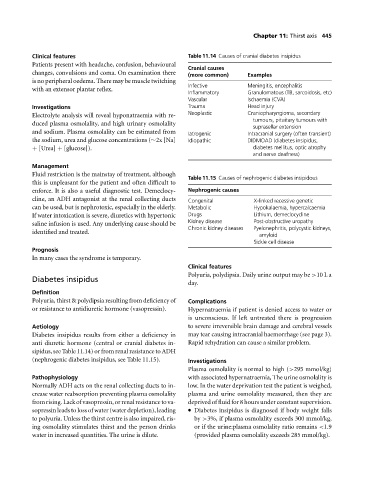Page 449 - Medicine and Surgery
P. 449
P1: FAW
BLUK007-11 BLUK007-Kendall May 25, 2005 8:5 Char Count= 0
Chapter 11: Thirst axis 445
Clinical features Table 11.14 Causes of cranial diabetes insipidus
Patients present with headache, confusion, behavioural
Cranial causes
changes, convulsions and coma. On examination there (more common) Examples
is no peripheral oedema. There may be muscle twitching
Infective Meningitis, encephalitis
with an extensor plantar reflex.
Inflammatory Granulomatous (TB, sarcoidosis, etc)
Vascular Ischaemia (CVA)
Investigations Trauma Head injury
Electrolyte analysis will reveal hyponatraemia with re- Neoplastic Craniopharyngioma, secondary
tumours, pituitary tumours with
duced plasma osmolality, and high urinary osmolality
suprasellar extension
and sodium. Plasma osmolality can be estimated from Iatrogenic Intracranial surgery (often transient)
the sodium, urea and glucose concentrations (∼2x [Na] Idiopathic DIDMOAD (diabetes insipidus,
+ [Urea] + [glucose]). diabetes mellitus, optic atrophy
and nerve deafness)
Management
Fluid restriction is the mainstay of treatment, although
Table 11.15 Causes of nephrogenic diabetes insipidous
this is unpleasant for the patient and often difficult to
enforce. It is also a useful diagnostic test. Demeclocy- Nephrogenic causes
cline, an ADH antagonist at the renal collecting ducts Congenital X-linked recessive genetic
can be used, but is nephrotoxic, especially in the elderly. Metabolic Hypokalaemia, hypercalcaemia
If water intoxication is severe, diuretics with hypertonic Drugs Lithium, demeclocycline
saline infusion is used. Any underlying cause should be Kidney disease Post-obstructive uropathy
Chronic kidney diseases Pyelonephritis, polycystic kidneys,
identified and treated.
amyloid
Sickle cell disease
Prognosis
In many cases the syndrome is temporary.
Clinical features
Polyuria, polydipsia. Daily urine output may be >10 L a
Diabetes insipidus
day.
Definition
Polyuria, thirst & polydipsia resulting from deficiency of Complications
or resistance to antidiuretic hormone (vasopressin). Hypernatraemia if patient is denied access to water or
is unconscious. If left untreated there is progression
Aetiology to severe irreversible brain damage and cerebral vessels
Diabetes insipidus results from either a deficiency in may tear causing intracranial haemorrhage (see page 3).
anti diuretic hormone (central or cranial diabetes in- Rapid rehydration can cause a similar problem.
sipidus, see Table 11.14) or from renal resistance to ADH
(nephrogenic diabetes insipidus, see Table 11.15). Investigations
Plasma osmolality is normal to high (>295 mmol/kg)
Pathophysiology with associated hypernatraemia, The urine osmolality is
Normally ADH acts on the renal collecting ducts to in- low. In the water deprivation test the patient is weighed,
crease water reabsorption preventing plasma osmolality plasma and urine osmolality measured, then they are
fromrising.Lackofvasopressin,orrenalresistancetova- deprived of fluid for 8 hours under constant supervision.
sopressin leads to loss of water (water depletion), leading Diabetes insipidus is diagnosed if body weight falls
to polyuria. Unless the thirst centre is also impaired, ris- by >3%, if plasma osmolality exceeds 300 mmol/kg,
ing osmolality stimulates thirst and the person drinks or if the urine:plasma osmolality ratio remains <1.9
water in increased quantities. The urine is dilute. (provided plasma osmolality exceeds 285 mmol/kg).

